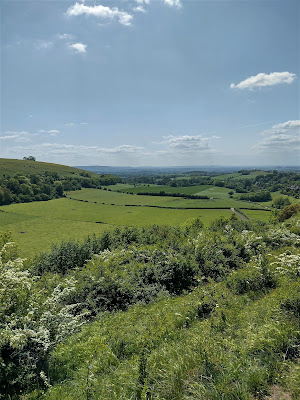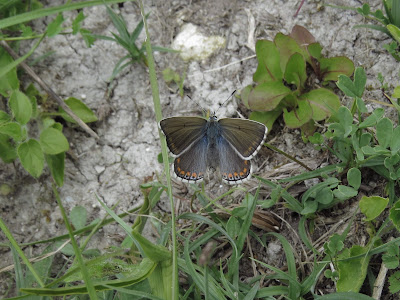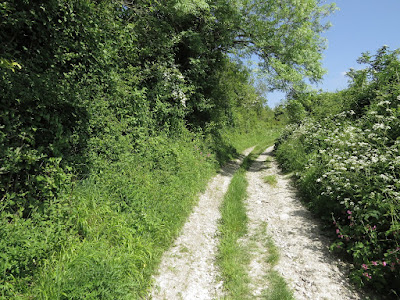It was rapidly becoming a wonderful week of butterfly watching. Following on from my trip to Giant Hill at Cerne Abbas where I saw the Duke of Burgundy butterfly, on a very warm Thursday I headed in the direction of North Dorset. This would be my first visit to Compton and Clubmen's Down, a site I'd not known about before. It's around ninety minutes from home but if nothing else the view from the car park on my arrival was worth the drive.
Just a few miles outside of Shaftesbury, this chalk downland site nestles opposite the possibly more famous Fontmell Down, which is well known, amongst other things, for glow worms. I'd come to Compton Down after doing a little research on the Dorset Butterflies website one evening. Compton's name kept cropping up as one of the best sites in Dorset for butterflies. Arriving then at 11am on this first visit I checked the website for the latest sightings from the previous day - 20 Adonis blue, 2 small blue, 1 marsh fritillary and then hidden in full sight - 2 Glanville fritillary. Really? Back in Somerset I live overlooking Sand Point where an introduced colony of Glanville has been repeatedly attempted, and where a few years ago I saw my only, very worn and tatty, Glanville. Although I've not heard of any recent sightings at Sand Point, I'd certainly not heard of Glanvilles being found outside of a couple of coastal sites in England and certainly did not expect it to be in Dorset. I checked earlier sightings and sure enough they were being regularly seen this week. What an opportunity, but where were they to be found on a massive hillside? The website suggested from the car park walk down the track for 300 meters and then enter the reserve. I had no idea where I was heading but down the very promising track I indeed went.
The first butterfly in the bag was a speckled wood, then a couple of brimstones, an orange tip, and a pair of green veined white. A little further on a worn blue butterfly floated by but at a speed where I couldn't be certain what it was, assuming (incorrectly I fear) a common blue. And then a dingy skipper flew into view. Not bad for a few paces down the cow parsley-decorated track.
Eventually I noticed a gap in the hedge where there were a few steps up to the hillside, and a gentleman coming down. Politely waiting for him to reach the bottom we had a brief chat as he drew close. "What are you looking for?" he said "Anything really, I'm trying to learn as much as possible". A conversation then took place. In summary, the hill is very good for marsh fritillary, he'd just counted 5 or 6 by the hedge, but suggesting, however, as this was my first visit I should have a look along the track bank from where we were chatting and downhill for a while. That's where the Glanville are. A little local knowledge is wonderful and it transpired he had been to this site for the first time himself yesterday, returning today to try and obtain additional images of the Glanville, of which he said 6 individuals had been seen yesterday. He offered to show me where he'd seen them so we set off slowly looking along the trackside bank.
And then the fun began. We'd gone a couple of paces when a stunning blue butterfly wafted by, then another, and another before getting my eye in I noticed a dozen or so drifting back and forth across the bank - "They're all Adonis blue" he said, "they'll be all the way down this slope, keep a look out for small blue as well" He wasn't kidding, half a dozen small blue flew back and forth in the next ten minutes, but our smallest blue butterfly was overshadowed by the Adonis blue. The Adonis were literally everywhere. I'd seen these vibrant blue males before but only in ones and twos. Here, today they were flying around us, behind us, in front of us perching on grass stems for what seemed ages and generally providing a butterfly spectacle I've not experienced before. Most were males with a smaller number of females.
They were so confiding. I tallied up when back home in the evening, I'd taken 148 images along this one track, trying to obtain the golden image. I never quite managed that but some here are okay in my view.
We'd been watching these butterflies for around half an hour now while slowly moving down the track. "There must be over 100 here " I suggested. There was a pause - "Nearer 200 possibly and when you go up on the hill there are about the same number on the lower slopes." He could be right as even in the small area directly in front of me I counted nine perched on the vegetation. There were so many we stopped taking images and simply carried on watching the Adonis in a trance-like state, all the while secretly hoping the Glanville would make an appearance stage right.
Reaching the end of the grass and flower covered part of this south facing bank, which I'd guess was no more than 100 to 150 metres in length, we noticed a mating pair of Adonis right beside us. Impervious to our presence they carried on while we voyeuristically snapped away.
Around this time another lepidopterist arrived, however it turned out he was doing research into, and filming of, the five spot burnet moth of which we'd only seen a couple. "Looking for the Glanvilles" he said as if the Adonis spectacle in front of us was so passé. "There were a number of them right where you are yesterday". It felt like one of those fishermen stories - suggesting greater things if I'd only been here the day before! "You might also see green hairstreak here" he added, "as they use this shrub as a territorial perch" (pointing to a pathetic specimen of a hawthorn). We thanked him as he headed a little further down the track searching for the eleven burnet moth cocoons he was keeping watch over. We never did see the green hairstreak.
His departure created a void, probably then the Glanville had gone, so my guide and I stood there simply watching the Adonis and chatting away, although I realised later I never knew his name.
"Have you seen the Adonis on the poo" my new-found friend said. I hesitated in my negative reply fearing this may be some trick question for a " he's not from around these here parts" journeyman lepidopterist like myself. "Come with me" he said and we walked a little further down the slope. Sure enough some expertly positioned poo was covered in Adonis. We watched this behaviour for ages, and at one point we counted between ten and 12 all taking whatever the mineral was they needed. As a spectator sport it leaves something to be desired, as a fascinating insight into butterfly ecology it was pure gold.
It was while intently watching this behaviour that out of the corner of my eye I noticed an orange brown butterfly on a stone, not 10 feet away. "Is that the Glanville?" I said. And it was. Perched on a stone that we'd either walked past or it had just arrived unnoticed. What a beautiful specimen it was too in this sunlight. Cameras positioned, we attempted that award winning image, it flew off, as I now know is normal butterfly behaviour as soon as a camera is used. But it flew only for a few feet before landing on a buttercup literally by our feet. Never in a million years did I think as I set off this morning I'd see a Glanville fritillary in mainland England. This pristine adult was stunning.
Mr five spot burnet man reappeared next to us on his way back up the track. "Oh you've found one then?" It turned out the larvae had been first reintroduced here in 2018 by someone unknown (I suspect though he knew), and then again in 2019 and 2020. Then the covid-19 lockdown prevented visiting and recording but in 2021 it was assumed but not confirmed that breeding had taken place as adults were on the wing two seasons after the last introduction. Adults were again seen in 2022 and this year more than ever have been recorded - possibly as many as 10. But why here? Well Glanvilles have a specific lifecycle and while ribwort plantain their food plant is plentiful here, this plant also needs exposed disturbed areas for it to flourish away from dense ground cover, and therefore for the Glanville to succeed. The books note Glanvilles are found mainly on a couple of coastal sites where regular erosion happens, principally the Channel Isles and the Isle of Wight. Historically they were also found in worked woodland and short turf downland. It seems a reasonable leap then to find them doing okay on this site where there is a similar arrangement. A farm track with bare chalk due to vehicle activity and just over the hedge the down grassland is managed by cattle which ruffle and kick up the thin turf exposing soil and chalk. The site is also full south facing so ideal for this warmth-loving butterfly. With breeding assumed to be happening it suggests this is a good habitat for them. Though whether the Glanville will remain here long term remains to be seen. But what a find though.
I realised that I'd spent nearly an hour and a half standing on this track in baking hot sunlight with the man with no name. I'd not yet set foot onto Compton Down itself where I wanted to now try and see some marsh fritillary. Saying my goodbyes to my new-found friend, who gave me further excellent instructions, I headed back up the track through the gap in the hedge and into the reserve itself, where immediately there were Adonis blue everywhere once more.
My instructions were to walk along a cattle path by the hedge, itself on top of the farm track bank I'd just been standing on, until I reached the field corner. The marsh fritillary would then be easy to to find.
Walking along this cattle track the grassland each side was, aside from small and Adonis blue, alive with grizzled and dingy skippers and small heath. Eventually I reached the point mentioned and there they were, at least three perched at different times on a grassy tussock or other raised bit of vegetation. They were quite active coming and going to these prominent perches which made taking photographs relatively easy. I was doing my best to notice the wing markings for future sightings when checking the time I realised I'd spent twenty minutes here not moving much. The afternoon heat was beginning to take its toll. I needed to return to the car and find some shade, but not before looking once more for small blue butterflies on the bank as so far I'd not managed a decent image.
In many ways I was reluctant to leave this beautiful downland, it was quiet, I was the only person there, and like everywhere this spring the hawthorn blossom was outstanding. But leave I now must and headed back to the track to look for the small blue.
It only took a moment to again locate these tiny butterflies on the wing, I didn't count them but they were regularly flying back and forth along the farm track bank as they had been doing since my first arrival well over two hours ago. However being so small and agile they easily disappear from view. I still did not manage the image I wanted, but it was fun watching them flit between or alight onto grass stems.
I'll finish with this image below, a right place and the right time capture. Focussing on a male small blue I took this shot just as an Adonis barged in to chase it off. And for me this was a perfect end to what had been close on three hours being enthralled and entertained by butterflies on a chalk downland.
As I headed back to the car Mr five spot was in a field filming something. I never did find out exactly what he was doing but it was intriguing. And that has been my abiding memory of this week - meeting really friendly butterfly observers who were keen to offer advice, but only if asked for, to this trainee lepidopterist. It has taken me nearly 60 years to be hooked by butterflies, I've a lot of catching up to do.


























Super photos Andrew of your wonderful day out and what a location for butterflies!!!! Amazing about the Glanville Fritillary! I didn't realise they could be seen in Dorset although I have heard of unofficial "introductions" in various places. So glad you have seen the species.
ReplyDeleteI've too found when I have been out looking for butterflies that many butterfly fans can be exceedingly helpful and willing to share knowledge.
Likewise Caroline I had no idea the Glanvilles were in Dorset - I'm assuming the reintroduction wasn't official, but however they got there made for a very memorable day for me.
ReplyDelete